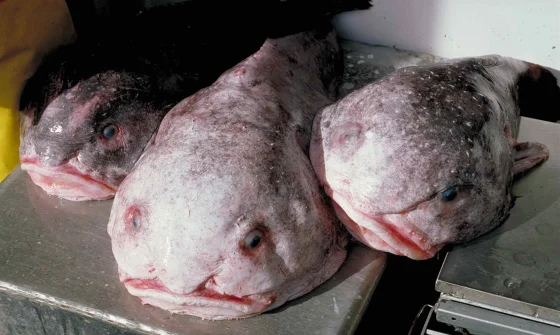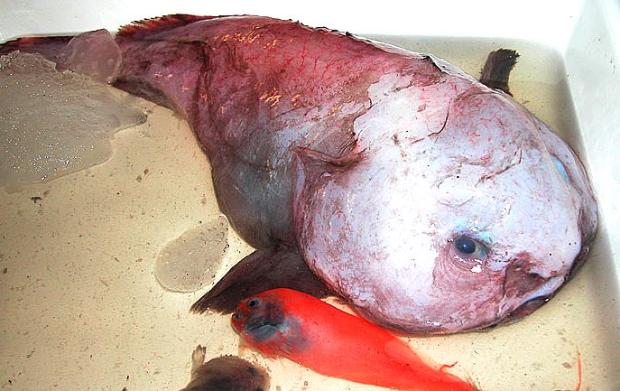Blobfish Named New Zealand’s Fish of the Year: The Rise of an Unlikely Champion.
Once labeled the “world’s ugliest animal” for its gelatinous, droopy appearance, the blobfish (Psychrolutes marcidus) has now been recognized as New Zealand’s Fish of the Year, marking an unexpected victory for a species that has long been misunderstood.
The Mountain to Sea Conservation Trust, the organization behind the annual competition, aims to raise awareness about New Zealand’s diverse marine and freshwater species. This year, the blobfish won with nearly 1,300 votes out of more than 5,500 cast, overtaking the orange roughy, another deep-sea species that was leading until a last-minute push from local radio station hosts.
The surprising win has reignited public curiosity about the blobfish, a deep-sea dweller that lives at extreme depths and possesses unique adaptations that allow it to survive in one of the most hostile environments on Earth. But beyond its peculiar appearance, the fish serves as an important reminder of the threats facing deep-sea ecosystems, as well as the growing need for marine conservation.
What is the Blobfish?
It is a deep-sea species found primarily off the coasts of Australia and New Zealand, at depths ranging from 600 to 1,200 meters (2,000 to 4,000 feet). At these depths, the water pressure can be up to 120 times greater than at the surface—enough to crush most human-made submarines.
A Unique Adaptation to the Deep Sea
The gelatinous body of the fish is an evolutionary adaptation to these extreme pressures. Unlike most fish, the blobfish does not have a swim bladder (the gas-filled organ that helps fish maintain buoyancy). Instead, it relies on its low-density, jelly-like flesh to float just above the ocean floor, where it passively waits for food to drift by.

Many people are shocked by the blobfish’s unusual appearance, but in its natural deep-sea habitat, it actually looks much more like a regular fish. The infamous “blobby” look only appears when a blobfish is brought to the surface, where the sudden release of pressure causes its body to expand and collapse.
Why Did the Blobfish Win Fish of the Year?
The Mountain to Sea Conservation Trust’s Fish of the Year competition was created to highlight underappreciated or vulnerable marine species in New Zealand. This year’s contest saw a tight race between the blobfish and the orange roughy, another deep-sea species.
The orange roughy, a deep-sea fish that is highly sought after in commercial fishing, was the frontrunner for much of the voting period. However, local radio station hosts Sarah Gandy and Paul Flynn of More FM launched a last-minute campaign to secure victory for the fish.
“The blobfish has been bullied its whole life,” the radio hosts said. “It’s time for the to have its moment in the sun.”
Their efforts paid off, and the fish emerged as the winner, proving that even the most unconventional-looking creatures deserve recognition and conservation efforts.
Although the blobfish has become famous for its unusual appearance, it plays a crucial role in deep-sea ecosystems. As a scavenger, it helps clean up the ocean floor by consuming small crustaceans, sea urchins, crabs, lobsters, and mollusks.
The deep-sea environment is one of the least explored and understood regions of the planet. Despite this, it plays an important role in global climate regulation, including carbon storage and nutrient cycling. The fish, along with other deep-sea creatures, is part of a complex food web that helps maintain ecological balance in these extreme environments.
The Threats Facing the Blobfish
Even though the fish lives far below the surface, it is not immune to human activities. The biggest threat to fish populations is deep-sea trawling, a destructive fishing method that involves dragging massive nets across the ocean floor.
Deep-Sea Trawling and Habitat Destruction
Trawling is used primarily to catch deep-sea fish like the orange roughy, but it often captures blobfish as bycatch—unintended victims of commercial fishing. Because the fish has no commercial value, it is usually discarded after being caught, but the damage to its population is significant.
The process of trawling destroys delicate deep-sea habitats, including coral reefs and rocky seabeds, which take thousands of years to recover. This habitat destruction affects not just the blobfish, but an entire ecosystem of deep-sea creatures.

Climate Change and the Deep Sea
Climate change is also affecting deep-sea environments in ways that scientists are only beginning to understand. Rising ocean temperatures, changes in oxygen levels, and shifts in deep-sea currents could have long-term impacts on blobfish populations.
Because deep-sea creatures like them are highly specialized to their environment, even small changes in ocean conditions can threaten their survival.
Despite its fame, scientists still know very little about the fish. Because it lives so deep below the ocean surface, studying it requires the use of deep-sea submersibles and remotely operated vehicles (ROVs).
How Do Blobfish Reproduce?
Very little is known about the reproductive habits of the blobfish. However, some studies suggest that female blobfish lay thousands of pink eggs on the ocean floor, and in a rare example of deep-sea parental care, they stay with the eggs to protect them from predators.
This behavior is unusual among deep-sea fish, which typically abandon their eggs after spawning. Scientists believe that this parental investment may help increase the survival rate of young blobfish.
The blobfish became a global sensation in 2013, when it was voted the “World’s Ugliest Animal” by the Ugly Animal Preservation Society. The campaign was designed to raise awareness for endangered and underappreciated species, many of which do not receive the same level of conservation attention as “cute” animals like pandas and dolphins.
Since then, the blobfish has become a pop culture icon, appearing in memes, cartoons, and plush toys. Its “so-ugly-it’s-cute” appeal has turned it into an unlikely symbol for marine conservation.
Although the blobfish is not officially listed as an endangered species, scientists believe that deep-sea trawling and habitat destruction could pose a serious threat to its long-term survival.
Steps to Protect the Blobfish and Deep-Sea Ecosystems
- Ban Deep-Sea Trawling
Some countries, including New Zealand, have begun banning trawling in certain deep-sea areas to protect vulnerable marine ecosystems. - Increase Research on Deep-Sea Species
More scientific research is needed to understand blobfish populations, reproductive habits, and ecological roles. - Support Marine Protected Areas
Expanding marine protected areas (MPAs) can help preserve deep-sea habitats and protect species like the blobfish. - Raise Public Awareness
The Fish of the Year contest has shown that public awareness can lead to increased conservation efforts. By educating people about deep-sea species, we can help advocate for stronger protections.
The blobfish’s victory as New Zealand’s Fish of the Year is a testament to the power of public awareness and conservation efforts. Once ridiculed for its unusual appearance, the blobfish has now become a symbol for the importance of preserving marine life—even the creatures that don’t fit traditional ideas of beauty.
By protecting the deep-sea environments where blobfish and other unique species live, we can help ensure that these fascinating creatures continue to thrive for generations to come.










